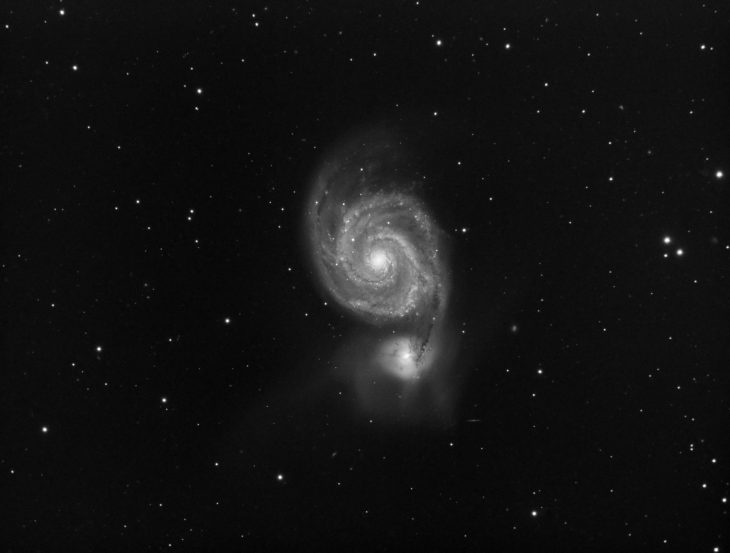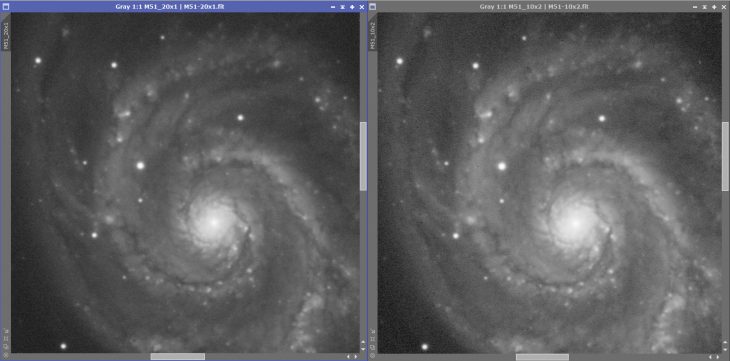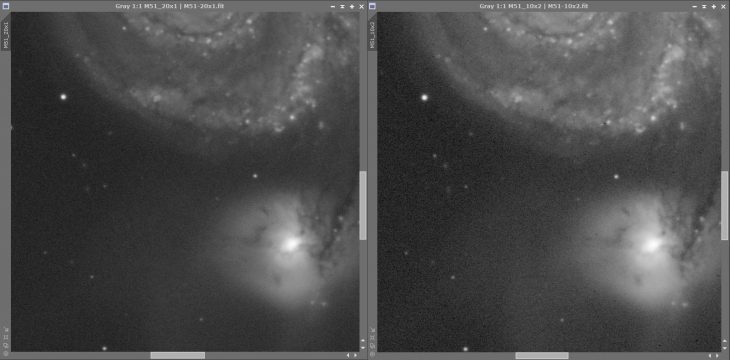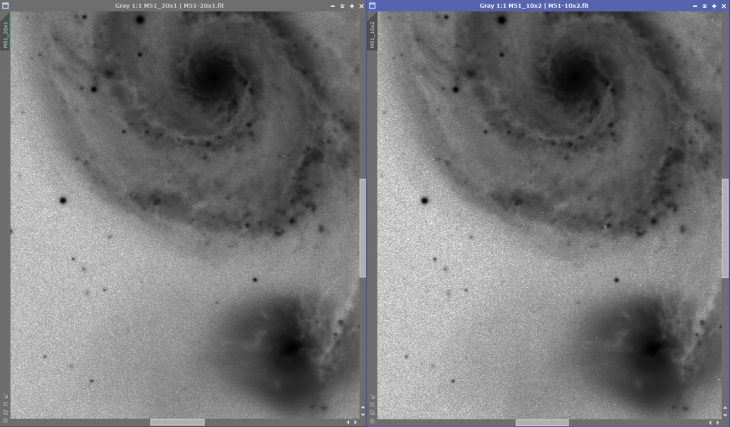Once we start to image with CMOS cameras, then we need to deal with more settings than with CCD cameras. I described some of them before, but now I decided to seek for optimum CMOS camera gain setting for different setup and sky parameters.
What is gain in CMOS camera? It is equivalent of ISO setting in consumer cameras. Gain does not actually makes camera more sensitive. It only amplifies signal read from pixel before it is converted to digital value. So why to change it at all? The answer is: because of read noise and quantization error.
Read noise
Read noise is the noise added each time to each frame. We measure it in electrons [e]. For CCD cameras it is constant value. For CMOS cameras it changes with gain setting, because in CMOS sensors read noise contains two components – one that is amplified, and one constant. Read noise for CMOS camera has highest value for zero gain, and its value lowers with increasing gain until it reaches some value (usually given by camera manufacturer as read noise). What we need to achieve is to keep low ratio of read noise to total noise in each frame.
Quantization error
Quantization error comes from limited ADC converter resolution. For 12 bit converter its resolution is 4096, and when camera pixel has capacity for example 16,000 electrons, then we cannot resolve signals that differs with less than 4 electrons and resolution is lost, and missing part is truncated or rounded. What we need to achieve here is to keep close to unity gain. That of course has some side effects.
Both marked with bold font necessities can be achieved with gain increase. When we increase gain, then read noise is getting lower. And also when we increase gain, the effective pixel capacity is getting lower, so also quantization error is reduced.

Low read noise and low quantization error are benefits, but low pixel capacity is an obvious disadvantage. So choosing proper CMOS camera gain will be always a compromise. If we set gain high – we get lower noise, but more areas will be oversaturated. For low gain we can get highest dynamic ratio in single exposure, but total noise will be higher and quantization error may become visible in some shade areas. Final choice will be affected by many aspects: local light pollution, telescope focal ratio, filters we use and our target, but usually in astroimaging you care more about low noise, than for oversaturated stars (except for some rare cases). In this entry I will show some comparison I made with zero and unity gain on imaging M51 galaxy.
Low and high gain stack comparison
Setup I used contained: Meade ACF 10″ telescope with CCDT67 telecompressor (f/7.5) and QHY163M camera. Sky quality: suburban sky, good transparency (NELM 5mag), moderate seeing. Filter: Baader L filter.
I made two series of subframes:
- 20 x 1 minute with gain=100, offset=70, calibrated with 40 darks and 20 flats
- 10 x 2 minutes with gain=0, offset=40, calibrated with 20 darks and 20 flats
Subframes after calibration were stacked in MaxIm DL with Average algorithm to avoid advanced stacking algorithms influence. Levels of both stacks were equalized with Linear Fit function in Pixinsight software.
First comparison presents both stacks stretched with STF function:

Large version: https://astrojolo.com/wp-content/uploads/2018/05/comp_stf.jpg
At first glance there is not much difference here, but when you enlarge full version, then left image (made with higher gain) presents little bit less noise. It can be noticed for example in lower part, where subtle halo around smaller galaxy is better revealed.
Next two comparisons are 1:1 crops of different image parts:

Large version: https://astrojolo.com/wp-content/uploads/2018/05/comp_ht_2.jpg

Large version: https://astrojolo.com/wp-content/uploads/2018/05/comp_ht_1.jpg
In these enlarged images difference is more visible. Left image (with higher gain) are significantly better – noise is lower, and details are better.
Last comparison is inverted image:

Large version: https://astrojolo.com/wp-content/uploads/2018/05/comp_ht_inv.jpg
Inverted image also confirms previous observations.
Something that is visible with an eye, should also be measurable. I compared both stacks in MaxIm, and results also confirmed previous observations:

Large version: https://astrojolo.com/wp-content/uploads/2018/05/comp_maxim.jpg
Both noise is lower at 20×1 minutes stack with gain=100, and also measured SNR for two example stars is better on left image.
Summary
I did similar comparison before with the same camera and filter but with faster telescope f/5.5 and differences were smaller. There is no clear border between factors that would determine using high or low gain. But there are some guidelines to consider before you choose gain for your specific purpose. I collected them in the small table below:
| Factor | Low gain | High gain (unity) |
|---|---|---|
| Exposure time | Long exposure time | Short exposure time |
| Focal ratio | Fast telescopes (f/5 or faster) | Slow telescopes |
| Sky quality | Light polluted skies | Dark sky locations |
| Filters used | Wide band filters (LRGB, photmetric) | Narrowband filters (Ha, Oiii, Sii) |
You may take a look and check for your conditions. For example if you have slower telescope and use it under dark skies, then higher gain will be a choice. Also for narrowband filters under moderate skies also higher gain would be the choice. The good news is that the differences are really subtle, unless you choose really wrong (like 1 minute exposures through H alpha filter with zero gain). But for modern CMOS cameras I would recommend to use unity gain for imaging. If you planned 100 minutes LRGB session in my opinion it will be better to shot 50 images with 2 minute exposure at unity gain, then 20 subframes with 5 minutes exposure at zero gain.
I will present some more examples in the future – with narrowband filters. (here is part II)
Clear skies!

